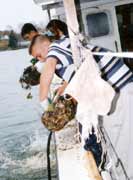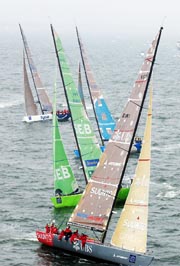 Bay Hero and Bay Zero
Bay Hero and Bay Zero
Gov. Parris Glendening
Who says Baysiders are conflicted? Their separate votes for Biggest Hero and Biggest Zero, both for Gov. Parris Glendening, that's who. Glendening has been around nearly eight years now, plenty of time to rub people both ways.
On the positive side, the ex-professor presided over good economic times in Maryland and established himself as the most pro-environment governor in the state's history.
On the other hand, he's a tad nerdy and liberal for many folks, and some might think that the new father — Gabriella Mona was born to the governor and his new wife Jennifer Crawford on August 18 — was too mischievous as far the affairs of state, so to speak. Still, his rejection probably has more to do with the line from a Laurie Anderson song, "I don't like the color of your sweater any more."
Best Use of Public Funds
Preservation
In recent years, with our greenspace dwindling, Maryland has been in the forefront of states working to save land from developers’ bulldozers. Following the advice of our late controller (and land-owner) Louis Goldstein that “the Good Lord’s not making any more land,” Maryland has preserved a million acres of land — 250,000 in the last eight years — from development, whether by outright purchase, purchase of development rights or conservation easements. That’s in addition to creative preservation investments being made by private land trusts in both Calvert and Anne Arundel counties.
In this somewhat surprising vote, our readers are offering their support for efforts to acquire public lands that all of us can enjoy.
Worst Use of Public Funds
Stadiums
Fond memory brings the light
Of other days around me.
“Oft in the Stilly Night”
Thomas Moore, 1779-1852.
Conversely, memory not-so-fond brings the darkness of other days around us. Neither I nor Bay Weekly readers can wipe from our memory the biggest give-away of all since the Dutch purchased Manhattan for a handful of trinkets. When the city and state squandered funds to house the Ravens, Bay readers overwhelmingly protested — and still do. Politicians, let it be known we have long memories.
Best Fundraiser
Cancer Crusade Gala
Since 1982, Southern Marylanders have come together to celebrate life at Rod ‘n’ Reel’s Annual Cancer Gala, in support of the American Cancer Society. So great is their support that citizens and sponsors routinely contribute a quarter of a million dollars, with each year topping the previous record. All that money goes to fight cancer through local support, state research and national collaboration.
That’s how it was once more this year. On August 1, thousands of folks joined together at the water’s edge to keep up the tradition. What an evening it was. Each year, Mother Nature offers a new gift. This year, she staged a light show in the sky, first rolling in clouds backlit by the waning sun, then streaking the velvet of nighttime with bolts and webs of lightning.
Local talent contributed the music, and the Rod ‘n’ Reel family — including watermen docked there — volunteered their services. As for food and drink, Gala host and Chesapeake Beach Mayor Gerald Donovan stayed to a tried-and-true formula: A banquet including lobster and crab, roast beef and barbecue, sides and desserts galore — plus open bars.
Where else can you and all your friends eat, drink and be merry while helping raise a quarter of a million dollars for a cause everybody can relate to? No place better than this, say Bay Weekly readers again this year.
Best Effort to Improve the Environment
Chesapeake Bay Foundation
In 2001, with the support of its 110,000 members, the Chesapeake Bay Foundation and its OysterCorps volunteers planted more than two million oysters on reefs and played a key role in advancing blue crab conservation Bay-wide.
 These are some of the reasons Bay Weekly readers voted the Chesapeake Bay Foundation winner of the Best Effort to Improve the Environment Award.
These are some of the reasons Bay Weekly readers voted the Chesapeake Bay Foundation winner of the Best Effort to Improve the Environment Award.
In underwater grass restoration, key habitat for blue crabs and rockfish, nearly 10,000 students and Foundation volunteers grew and planted 100,000 underwater grass plants in 15 sites in Maryland, Virginia and Pennsylvania. The Foundation broke new ground in underwater grass restoration by using an innovative grass planting boat capable of planting an acre of underwater grass in a single day.
 Thanks to the collective efforts of farmers and landowners, resource agencies and environmental groups, and a new Farm Bill program from the U.S. Department of Agriculture, the Bay Program's watershed goal of 2,010 miles of riparian buffers was met eight years ahead of schedule. The Foundation has also spent more than $7 million of its own funds to help farmers and landowners implement Bay-saving conservation practices.
Thanks to the collective efforts of farmers and landowners, resource agencies and environmental groups, and a new Farm Bill program from the U.S. Department of Agriculture, the Bay Program's watershed goal of 2,010 miles of riparian buffers was met eight years ahead of schedule. The Foundation has also spent more than $7 million of its own funds to help farmers and landowners implement Bay-saving conservation practices.
Bay Weekly Readers appreciated that the Chesapeake Bay Foundation is a member of Restore America's Estuaries, a national coalition of 11 community-based organizations working to save our coastal areas, and has designed the Anacostia River Initiative to secure the political commitment to clean up the unhealthy and over-polluted Anacostia — and to get the governments involved in actually doing it.
This dedication to the environment and the Bay is why readers chose the Chesapeake Bay Foundation for the Best Effort to Improve the Environment Award.
Biggest Issue Needing Attention
Pollution
We're glad the winner here didn't turn out to be the Baltimore Orioles' outfield, or something equally spurious. We thought readers might say the economy needs attention. But in concluding that pollution is the biggest issue on the horizon, our readers affirmed their concerns about the Chesapeake Bay and sent a clear message to this year's crop of political candidates. We've made some strides since the Bay restoration effort began in earnest. But the startling decline of oysters and crabs in recent years points to the need to ratchet up the effort. Bay-choking nitrogen — from sewage treatment plants, farms and lawn chemical junkies — continues to cause problems.
Best Thing to Happen to the Bay the Past Year
Volvo Ocean Race
The round-the-world Volvo Ocean Race’s Annapolis stopover buoyed the local economy and secured the city’s standing as America’s sailing capital. Mayor Ellen Moyer, who helped lure the race here four years ago, dubbed it an “international magnet.” Now Bay Weekly readers say it’s the best thing that happened to Chesapeake Country in the past year.
 Eight yachts competed in last year’s nine-month test of endurance, crewed by skilled sailors of diverse nationalities. The racers weathered Arctic gales and tropical doldrums, faced massive waves and torrential rains, dodged whales, water spouts and icebergs, suffered bumps, bruises, gashes, rashes, severe sunburns, broken masts and lost sails. They reminded local sailors that a bad day at sea means much more than running out of beer.
Eight yachts competed in last year’s nine-month test of endurance, crewed by skilled sailors of diverse nationalities. The racers weathered Arctic gales and tropical doldrums, faced massive waves and torrential rains, dodged whales, water spouts and icebergs, suffered bumps, bruises, gashes, rashes, severe sunburns, broken masts and lost sails. They reminded local sailors that a bad day at sea means much more than running out of beer.
The battered boats arrived in Baltimore from Miami, then paraded into Annapolis on Friday, April 26, for a weekend of festivities. Everyone involved with the Ocean Race was sorry to say good-bye.
“I hope this race comes to Annapolis again,” one sailor said. “There’s so much interest here — more than any other country.”
Local fans logged on to the race’s website to follow the further adventures of winning skipper John Kostecki, who captained Chessie Racing’s entry into the 1998-1999 race, then called the Whitbread. Juan Vila, who crewed with Kostecki on Chessie, was with him again as navigator, and a number of Annapolis residents sailed on other boats. Moreover, six of the eight yachts competing were designed by Bruce Farr’s Annapolis firm.
The boats crossed the finish line in Germany on June 9, after 132 days at sea. A month later, an appreciative crowd assembled at the Maryland Hall to relive the sights and sounds of the race, thanks to ESPN sailing analyst and Annapolis resident Gary Jobson. Jobson debuted an hour-long compilation of video footage from ESPN, the BBC and various other sources called Fighting Finish.
Volvo will sponsor another round-the-world race, starting from Europe in autumn 2005. Annapolis was among the race’s most popular stops, and local enthusiasts would love to be included again, but Jobson says race officials “like it when a stopover has a boat entered.” He also says Chesapeake Country may do just that, as Chessie Racing did in the 1998 race.
While you’re waiting for it to return, turn to Fighting Finish as a video or soon a book of the same title. Check out www.volvooceanrace.com, www.vorchesapeake.org and www.eastportyc.org for updates.
Worst Thing to Happen to the Bay in 2001
Crab Population Decline
Alas, it is true.
The once abundant Bay, filled with blue crabs, is now drying up. While fishermen used to bring in over 50 million pounds of crabs in the ’80s, this year they have to make due with an expected 20-25 million pounds.
That is why Bay Weekly readers chose the crab population decline as the worst thing to happen to the Bay in 2001.
According to the 2002 Chesapeake Bay Blue Crab Advisory Report, the abundance of Chesapeake Bay blue crabs over five inches continues to be below the long-term average and has been in decline in recent years. The abundance of mature females, or spawning stock, remains well below the long-term average, with 2000 and 2001 estimates being the lowest on record. And the number of juvenile blue crabs entering the Chesapeake Bay population has continued the decline that began in the early 1990s. The report also says that reduced blue crab harvests in 2001 were primarily due to low blue crab populations, while new management measures in 2001 provided additional protection.
The Advisory Report bases its findings on data collected from five long-term fisheries surveys conducted annually throughout the Bay.
The crab population decline also had a part in the first Chesapeake Bay health decline in recent years, in addition to excessive water pollution and accelerated loss of land to sprawl, leaving Bay health at barely more than a quarter of historic levels at 27 out of 100 on the Chesapeake Bay Foundation’s index. This is the Bay’s first decline since 1998, when the Foundation first published the annual report.
Looks like Bay Weekly readers know a bad thing when they see it.
 Best Bet for Next Gov
Best Bet for Next Gov
Kathleen Kennedy Townsend
It's obvious that our survey was completed before the shifting fortunes in this year's gubernatorial campaign became clear. Townsend, a Democrat, is probably still the favorite in her race against Rep. Robert Ehrlich. But her lackluster performance so far, her inability to make a persuasive case to African Americans, and her inattention to details (like returning Bay Weekly's candidate questionnaire, as Ehrlich did) suggest that she might find a way to lose this race. Lucky for her, it's still relatively early in the game.